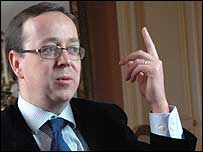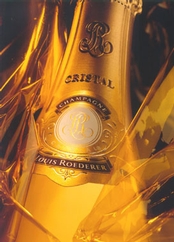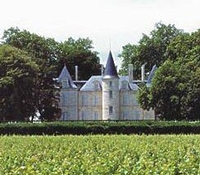During the past two decades, Champagne Louis Roederer, a prestigious, family-owned, medium-sized Champagne house, has become one of the most important wine firms in the world. It has accomplished this by acquiring or founding other wineries at a rather rapid rate. Champagne Roederer’s latest acquisition, in 2006, was a stunner--the great Bordeaux Super-Second Growth, Château Pichon-Longueville Comtesse de Lalande, long regarded as one of Bordeaux’s top ten red wines.
prestigious, family-owned, medium-sized Champagne house, has become one of the most important wine firms in the world. It has accomplished this by acquiring or founding other wineries at a rather rapid rate. Champagne Roederer’s latest acquisition, in 2006, was a stunner--the great Bordeaux Super-Second Growth, Château Pichon-Longueville Comtesse de Lalande, long regarded as one of Bordeaux’s top ten red wines.
Champagne Louis Roederer’s portfolio of wineries that it wholly or partially owns reads like a “Who’s Who” of fine wines: Champagne Deutz; Roederer Estate and Scharffenberger Cellars in California; Porto Adriano Ramos-Pinto; Delas Frères wines from the Rhône Valley; Domaines Ott from Provence; Château de Pez, Château Haut-Beauséjour, and Château Bernadotte in Bordeaux, and Glenelly Winery in South Africa.
The Louis Roederer firm established its own importing and marketing firm in California in 1987, Maisons Marques & Domaines USA. MMD USA, as it is known, besides handling all of the sales and marketing for Roederer’s properties in the U.S., also represents some of the famed Bordeaux producer Jean-Pierre Moueix’s wines, such as Dominus and Napanook in Napa Valley; Château Loudenne fom Bordeaux; Baron de Ladoucette from the Loire Valley; Domaines Schlumberger from Alsace; Agricola Quercibella from Tuscany and Pio Cesare from Piedmont; Marqués de Murrieta from Rioja; Meerlust and Distell wines from South Africa; and Carpe Diem wines (owned by MMD USA) from Edna Valley.
Champagne Louis Roederer’s unusual success story starts, of course,  with the excellence and accomplishments of its own Champagne. Looking at its history, I can see that two people have played a major role in this House’s success, Madame Camille Olry-Roederer and her grandson, Jean-Claude Rouzaud. And if I were to add a third person, it’d be Jean-Claude’s son, Frédéric Rouzaud, current head of Louis Roederer.
with the excellence and accomplishments of its own Champagne. Looking at its history, I can see that two people have played a major role in this House’s success, Madame Camille Olry-Roederer and her grandson, Jean-Claude Rouzaud. And if I were to add a third person, it’d be Jean-Claude’s son, Frédéric Rouzaud, current head of Louis Roederer.
The firm was founded in 1776, and purchased by the Roederer family in 1819--making it one of the oldest family–owned houses in Champagne. In 1833, Louis Roederer inherited the winery from his uncle; since then, it has carried the Louis Roederer name. What first put the house on the world map was its creation of Champagne’s first prestige cuvée, Cristal, for Tsar Nicolas II of Russia in 1876. Russia was to become a huge market for Louis Roederer. At that time, Cristal was a sweet Champagne, as were practically all Champagnes. By 1890, the decade of the Belle Epoque, Champagne Louis Roederer was one of the leading Houses, producing 2.5 million bottles, 10% of the entire Champagne production then being made.
When disaster struck the wine world in the 20th century in the form of World War I, Prohibition in the U.S.A., and the Great Depression, many wineries throughout the world were forced to close. Léon Olry-Roederer, head of the firm, died in 1932, leaving Champagne Louis Roederer to his widow, Camille. She turned out to be one of the indomitable Champagne widows who have been so important to the history of the region. Camille took a moribund business, guided it through the Depression and World War II--including German occupation of Champagne--and emerged during the post-war years of the 1960s and ‘70s as arguably the strongest and financially most successful Champagne house of all. How did she do it? Camille was smart enough to purchase vineyards in the top Champagne regions whenever she could during her stewardship.
wineries throughout the world were forced to close. Léon Olry-Roederer, head of the firm, died in 1932, leaving Champagne Louis Roederer to his widow, Camille. She turned out to be one of the indomitable Champagne widows who have been so important to the history of the region. Camille took a moribund business, guided it through the Depression and World War II--including German occupation of Champagne--and emerged during the post-war years of the 1960s and ‘70s as arguably the strongest and financially most successful Champagne house of all. How did she do it? Camille was smart enough to purchase vineyards in the top Champagne regions whenever she could during her stewardship.
When Camille Olry-Roederer passed away in 1974 after 42 years (Why do the women live so much longer than the men in Champagne, I’ve always wondered), Champagne Louis Roederer’s own vineyards supplied 70% of its needs, an obvious financial advantage over its rivals. No other Champagne house owns this high a percentage of vineyards. Camille Olry-Roederer also re-established Cristal, a dry Champagne after World War II, as the most sought-after and most prestigious Champagne in the world.
In 1979, grandson Jean-Claude Rouzaud, an experienced winemaker, took over Louis Roederer. At the time, the House was producing less  than a million bottles. Rouzard started re-building the Louis Roederer business. One of his wisest moves was to acquire vineyard land in cool Mendocino in 1982, leading to the founding of Roederer Estate, California’s most critically acclaimed sparkling wine house. I don’t know any sparkling wine in the world as good as Roederer Estate in the $19-$20 retail range, and its dry Rosé, for about $25, is exquisite. Roederer Estate’s prestige cuvee, L’Ermitage, which retails for around $40, is a tremendous value as well.
than a million bottles. Rouzard started re-building the Louis Roederer business. One of his wisest moves was to acquire vineyard land in cool Mendocino in 1982, leading to the founding of Roederer Estate, California’s most critically acclaimed sparkling wine house. I don’t know any sparkling wine in the world as good as Roederer Estate in the $19-$20 retail range, and its dry Rosé, for about $25, is exquisite. Roederer Estate’s prestige cuvee, L’Ermitage, which retails for around $40, is a tremendous value as well.
Today, Champagne Louis Roederer produces 3.3 million bottles annually. Jean-Claude’s son, Frédéric Rouzaud, took over in January, 2006. In fact, it was Frédéric who organized the acquisition of Château Pichon-Lalande as well as Domaines Ott. Frédéric Rouzaud also played a key role in acquiring Champagne Deutz, one of my favorite Champagnes. I love Deutz’s Blanc de Blancs, as well as its superb prestige cuvees, Cuvée William Deutz and Cuvée William Deutz Rosé. Champagne Louis Roederer has not lost a step with Frédéric Rouzaud at the helm, with his dad still consulting, as Chairman of the Board.
Louis Roederer Champagne’s house style is full-bodied and rich, with the exception of its prestige cuvee, Cristal, which is elegant and exquisitely well-balanced. Chef de Cave Jean-Baptiste LeCaillon, who has been in charge of winemaking since 1999, has made a number of key improvements, including lowering the dosage to 9 grams per liter (8 grams for Cristal). One of my only complaints about earlier Roederer Champagnes had been that the dosage was a bit too high (it used to be 12 to 13 grams in its non-vintage Brut Premier).
Louis Roederer’s entire line of Champagnes is first-rate. It’s current NV Brut Premier, based on the 2005 vintage with up to 20% reserve wines, is fresh and lively. It has eight different vintages in the blend; Roederer has an amazing one million reserve wines, up to eight years old, in its cellars. The Brut Premier is 40% Pinot Noir, 40% Chardonnay, and 20% Pinot Meunier. Louis Roederer also produces a Vintage Blanc de Blancs, a Vintage Rose, and a Vintage Brut, all sturdy Champagnes, suitable companions at the dinner table.
Although Louis Roederer’s robust house style suggests its strength is in its Pinot Noir vineyards, over 40% of the vineyards it owns are Chardonnay vineyards in the Côte des Blancs, mainly Grand Cru. This is one of the reasons that its Cristal is such an exceptional Champagne.
I must confess that Louis Roederer Cristal is one of my very favorite wines in the world, and has been for some time. Its typical composition is 55% Pinot Noir, 45% Chardonnay, with the grapes coming entirely from Roederer’s own vineyards, almost all of which are rated Grand Cru. Some vintages of Cristal may have as high as 60% Pinot Noir or as low as 50%, with the remainder always Chardonnay. In a typical vintage, about 400,000 bottles of Cristal are produced, not a small amount--about the size of a First Growth Bordeaux such as Lafite-Rothschild--but tiny compared to Dom Pérignon, which might produce ten times as much (Moët & Chandon never reveals the amount). In any case, Cristal is almost always on allocation throughout the world, and is especially difficult to find in retail stores during the Holiday season.
wines in the world, and has been for some time. Its typical composition is 55% Pinot Noir, 45% Chardonnay, with the grapes coming entirely from Roederer’s own vineyards, almost all of which are rated Grand Cru. Some vintages of Cristal may have as high as 60% Pinot Noir or as low as 50%, with the remainder always Chardonnay. In a typical vintage, about 400,000 bottles of Cristal are produced, not a small amount--about the size of a First Growth Bordeaux such as Lafite-Rothschild--but tiny compared to Dom Pérignon, which might produce ten times as much (Moët & Chandon never reveals the amount). In any case, Cristal is almost always on allocation throughout the world, and is especially difficult to find in retail stores during the Holiday season.
I realize, of course, that Cristal is such a “status symbol” that much of it (most of it?) is consumed by celebrities in the entertainment world, all of them drinking it much too young, I might add, when it is impossible to appreciate the true greatness of this Champagne.
Aged for five to six years in Roederer’s cellars, depending on the vintage, Cristal’s current vintage is 2002 (a very fine vintage!). It retails in the U.S. for $200 to $220 per bottle range. I believe that 2002 Cristal will be showing at its best 15 to 20 years from the vintage (closer to 20), if it is well-stored. A subtle, complex Champagne such as Cristal, made from the best vineyards, demands time to evolve. I strongly suggest that you do not consume the ’02 Cristal now.
I have tasted the incredible 1996 Cristal (1996 might be the greatest Champagne vintage of this generation; no vintage has been better at least since 1964) a couple of times recently, and it still so very young. If you are fortunate enough to own 1990 Cristal, or know a friend who has it, you should know that now would be the perfect time to drink it. Although 1990 was a very good, somewhat ripe, vintage in Champagne, it is totally evolved for the most part (Krug and Salon might be exceptions). The superb 1988 Cristal, on the other hand, although excellent now, is capable of several more years of maturing. A cool vintage, 1988 Champagnes have excellent acidity and are keeping well.
By the way, since the 1983 vintage, each bottle of Cristal comes wrapped in yellow cellophane, as a guard against ultra-violet rays from the sun, or any bright lights. Champagne Louis Roederer suggests that you keep Cristal wrapped in its cellophane until you are ready to drink it.
The truly exquisite and rare Cristal Rosé, which makes up only 5% of the entire Cristal production, is made from 70% Pinot Noir, 30% Chardonnay. Few retailers have it available, and I can’t recall the last time I saw Cristal Rosé on a restaurant wine list. The current vintage of Cristal Rosé, if you can find it, is the 2000, and it retails in the $500 to $600 per bottle range. Yes, an exorbitant price, but I don’t think I’ve ever had better rosé Champagnes in my life than the 1982, 1985, and 1988 Cristals.
Cristal Rosé’s longevity is as great as Cristal white, especially in great vintages. Cristal Rosé made its debut in an “off” vintage, 1974. I purchased it, out of curiosity, in the mid-1980s and drank it in 1989. It was magnificent, showing no signs of deterioration! Such pure flavors and great balance. If it can be this good in an off-vintage, I thought, what must it be like in a good vintage! I’ve been a fan ever since. And I’m in good company; the great wine writer Serena Sutcliffe once told me that Cristal was her favorite Champagne.
This column on Champagne Louis Roederer was prompted by a visit to the winery in Rheims, France, in June of this year. The occasion was a rare tasting of all of the wines in the Louis Roederer portfolio; winemakers from each firm were present and talked about their wines. I jotted just a few notes about some of the wines:
NV Roederer “Brut Premier” (magnum)--I enjoyed this Brut Premier so much because of its freshness; the magnum bottle might have helped. Just a lovely Champagne, with delicious fruit. Drink it while it’s young and lively.
Roederer Estate “L’Ermitage” 2002--The current release of Roederer Estate’s prestige cuvee. An interesting contrast to the Brut Premier, it is earthier on the palate, reflecting its Anderson Valley terroir. I loved it. Enjoyable now, but it will age well for several more years.
Champagne Deutz, “Amour de Deutz” 1999--Deutz’s prestige cuvee blanc de blancs. Rich, ripe style. I personally prefer Deutz’s standard blanc de blancs. The Amour is a bit too broad-shouldered for me. But I do love Deutz’s other prestige cuvees, Cuvée William Deutz 1998 and Cuvée William Deutz Rosé 1999, tasted earlier that week.
Domaines Ott (Provence), Château de Selle Rosé 2008--Grenache-based, with some Cinsault, Syrah, and Cabernet Sauvignon. I never tasted a better Domaines Ott Rosé, and now I realize that I’ve never tasted one as fresh as this. I would recommend never buying rosés such as this lovely Provence wine more than one year old.
Delas Frères (Rhône Valley) Hermitage 2006--What an improvement in this firm under its new ownership! This Hermitage rouge is just singing; great fruit and liveliness, enjoyable even now, but will develop more in three to five years.
Adriano Ramos-Pinto (Douro Valley) Duas Quintas Reserva 2005--This venerable port house has been producing this fine table red wine for a few years now, using traditional port grapes--50% Touriga Nacional, 30% Touriga Franca. A quality wine, comparable to a top Côtes-du-Rhône, but with livelier fruit. Duas Quintas’ winemaker suggests it will be even better with one more year of aging.
Château de Pez (St.-Estephe, Bordeax) 2004--Always one of my favorite Cru Bourgeois Bordeaux, and now even better with Louis Roederer in charge. Made with 50% Cabernet Sauvignon, 43% Merlot, 5% Cabernet Franc, and 2% Petit Verdot. This is a great 2004, a good but not a great vintage. Lively fruit, great structure, still quite young.
Château Pichon-Lalande (Pauillac, Bordeaux) 1996--A big bruiser  of a Pauillac, especially for the always elegant Lalande. Still very young, this ’96 will be a long-lasting wine, with ten or more years of aging ability. Drinking a Bordeaux this good, it’s easy to understand Pichon-Lalande’s status as a “Super-Second” Growth. The vintage was especially strong for Cabernet Sauvignon; this wine is 75% Cab Sauvignon, 15% Merlot, 5% Cab Franc, and 5% Petit Verdot.
of a Pauillac, especially for the always elegant Lalande. Still very young, this ’96 will be a long-lasting wine, with ten or more years of aging ability. Drinking a Bordeaux this good, it’s easy to understand Pichon-Lalande’s status as a “Super-Second” Growth. The vintage was especially strong for Cabernet Sauvignon; this wine is 75% Cab Sauvignon, 15% Merlot, 5% Cab Franc, and 5% Petit Verdot.